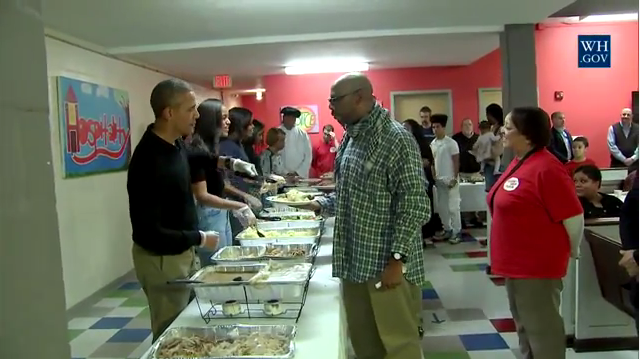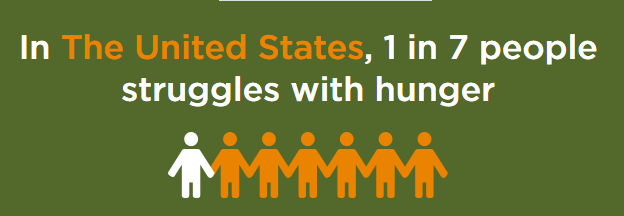
Yesterday, President Obama, accompanied by the First Daughters, Sasha and Malia, pardoned “Abe” and “Honest”, the National Thanksgiving Turkeys:
This year’s lucky turkey was “Abe,” an 18-week-old, 40-pound turkey raised in California’s Central Valley under the supervision of the National Turkey Federation.
“Abe is now a free bird. He’s TOTUS -– the Turkey of the United States,” Obama said.
“If for some reason Abe can’t fulfill his duties to walk around and gobble all day, Honest is in an undisclosed location ready to serve in the TOTUS line of succession,” he continued.
But another thing the First Family did was remind us that today people are hungry and that food insecurity is real.
Today at Feeding America, your dollars towards feeding the hungry will buy twice as many meals:

$1 buys 11 meals but today it will buy 22 thanks to a gift from Ameriprise Financial.
From FeedingAmerica.org: Hunger in America
The Feeding America network is the nation’s largest domestic hunger-relief organization. The nationwide network of food banks provides more than 3.6 billion meals to virtually every community in the United States through food pantries and meal programs.
Why Feeding America?
At Feeding America, 98% of all donations raised go directly into programs and services for people in need. Thanks to your support, the Feeding America nationwide network of food banks, pantries and meal programs serves virtually every community in the United States – more than 46 million people including 12 million children and 7 million seniors.
The Feeding America network provides over 3.7 billion meals to 1 in 7 Americans in need of healthy foods to help them live more secure and stable lives.
For 35 years, Feeding America has responded to the hunger crisis in America by providing food to people in need through a nationwide network of food banks.
The concept of food banking was developed by John van Hengel in Phoenix, AZ in the late 1960s. Van Hengel, a retired businessman, had been volunteering at a soup kitchen trying to find food to serve the hungry. One day, he met a desperate mother who regularly rummaged through grocery store garbage bins to find food for her children. She suggested that there should be a place where, instead of being thrown out, discarded food could be stored for people to pick up—similar to the way “banks” store money for future use. With that, an industry was born.
Van Hengel established St. Mary’s Food Bank in Phoenix, AZ as the nation’s first food bank. In its initial year, van Hengel and his team of volunteers distributed 275,000 pounds of food to people in need. Word of the food bank’s success quickly spread, and states began to take note. By 1977, food banks had been established in 18 cities across the country.
As the number of food banks began to increase, van Hengel created a national organization for food banks and in 1979 he established Second Harvest, which was later called America’s Second Harvest the Nation’s Food Bank Network. In 2008, the network changed its name to Feeding America to better reflect the mission of the organization.
Today, Feeding America is the nation’s largest domestic hunger-relief organization—a powerful and efficient network of 200 food banks across the country. As food insecurity rates hold steady at the highest levels ever, the Feeding America network of food banks has risen to meet the need. We feed 46 million people at risk of hunger, including 12 million children and 7 million seniors. Learn more about how we get food to people in need in our “How We Work” section. Support Feeding America and help solve hunger. Donate. Volunteer. Advocate. Educate.


Thanks, President Obama! ;)
The president spoke yesterday to reassure Americans that his national security team is being vigilant:
From Transcript: Remarks by the President After Meeting with National Security Team
Food insecurity in America: A grim holiday season awaits America’s hungry
After two years of “extraordinary needs”, there is no sign that things are getting better:
While the economy has improved, the funding for those in need has been cut drastically: